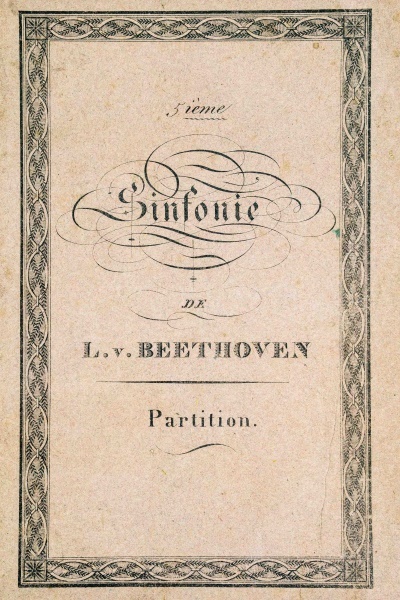Beethoven: Symphony No. 5 in C Minor, Opus 67
With one of the most distinctive melodic and rhythmic motifs in Western music, Beethoven’s Symphony No. 5 in C Minor, Opus 67 is a musical masterpiece that is easily and readily recognized. Although initial public reaction to the symphony was rather indifferent, upon publication it soon became a symbol for the changing concept of music as a deeply emotional, spiritual, and intellectual form of art, rather than a collection of sounds created solely for entertainment. In Beethoven’s time, symphonic works were generally considered to be little more than aristocratic divertissement: pleasurable music that was to be enjoyed upon first hearing. The fourmovement model of the late 1700s, provided by Mozart and Haydn—both of whom Beethoven had studied composition with— contained song-like melodies, lilting dance tunes, and clever, virtuosic, and exciting finales.
But with the creation of this work, Beethoven both radically changed the concept of the symphony and influenced the symphonic composers who followed him. The menacing and brooding nature of the opening theme, the predominant use of a minor key, the complexity of the melodic and rhythmic motives, and the extended length of the work all signaled to listeners that Beethoven had developed a new, bolder concept for this art form, one that engaged audiences in actually listening and contemplating the emotional meaning and impact of what they were hearing.
According to some sources, Beethoven characterized the four-note theme of the first movement as representing “Fate knocking at the door.” The opening theme was even adopted as a symbolic motif for Allied victory during the Second World War, since the short-short-short-long rhythm contained throughout the movement is also Morse Code for the letter “V.”
At the forefront of composers who struggled with the contemporary image of the composer/musician, Beethoven resented the concept of the artist as tradesman who served at the pleasure and biding of the aristocracy. His works were accepted and enjoyed by a newly developing middle class that looked to musical expression as a common form of public and private entertainment. His literary and musical contemporaries wrote about the symphony as a deeply emotional experience, one that resonated with the emerging philosophy of Romanticism and public interest in portraying profound emotional expression.
Just as contemporary scientists and engineers today use the most current available technology in their research, Beethoven composed his Fifth Symphony using the basic symphonic conventions of the time while expanding and challenging the limits of the technology available to him. Eliminating the slow introduction, common in symphonies at the time, Beethoven signaled the change of the symphony from a collection of elegant and sophisticated courtly tunes to a dramatic roller coaster, challenging the audience to accept a radically new form that engaged them in an adept musical manipulation of emotions.
He advanced the symphonic format by including innovations such as the prominent orchestrational addition and use of the piccolo and three trombones in the last movement. At the time, the trombone was an instrument usually reserved either for the accompaniment of liturgical choral music or to represent somber or morbid themes in opera scores. Beethoven’s inclusion of it as part of the orchestra expanded the size, range, tonal palette, and volume of the orchestra.
He also altered the form through changing the conventional nature of the movements. The rhythmically intense first movement is interrupted by a short rhapsodic and improvised-sounding cadenza played by the oboe. The second movement, conventionally a song form, is changed into several sets of theme and variations with dramatic elements. Finally, the third movement, a scherzo—which is usually a playful dance— is written in a suspenseful mood in C Minor. Through the use of an exciting transition and modulation, it ultimately leads without pause into the triumphal fourth and final movement in the key of C Major.
Still one of the most often performed pieces of symphonic music, Beethoven’s Fifth Symphony also remains one of the most discussed and familiar works in the orchestral repertoire. It is so iconic that it can be heard in everything from film scores to commercial background themes in popular media. Since it is such an important and popular symphony, it is programmed by most orchestras as a staple part of their repertoire and can be heard wherever symphonic music is performed.
—Richard Chenoweth, PhD, Professor, Music
Richard Chenoweth, Graul Chair in Arts and Languages, discusses the innovative symphonic structure for Ludwig van Beethoven’s most famous work. Interview is an online supplement to the University of Dayton exhibit Imprints and Impressions: Milestones in Human Progress—Highlights from the Rose Rare Book Collection, held Sept. 29 through Nov. 9, 2014.

